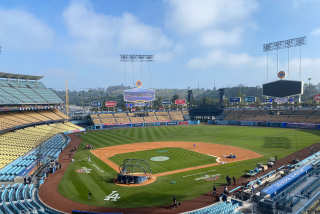Reds’ Fans Pay a Price to See Stars
- Share via
This will teach those Cincinnati Red fans for showering applause on Barry Larkin and influencing club owners to give their 36-year-old shortstop the three-year, $27-million contract he wanted--only a day after he’d exercised his veto rights on their attempt to trade him to the New York Mets.
Now, those fans are probably going to have to help pay for the new contract.
The Reds are expected to become the first team to raise ticket prices during the season.
“We listened to our fans, we brought on two superstar players [Ken Griffey Jr. being the other] and there’s a price that goes with that,” Chief Operating Officer John Allen said. “We also pride ourselves on the fact that our ticket prices have been the 28th lowest among the 30 teams.”
Griffey received a nine-year, $116.5-million contract, of which $57 million is deferred. He had told the Reds he was willing to defer even more if it would help pay for Larkin, but the Reds, whose attendance is up 38% and could break the 1976 club record of 2.6 million, will use other means, among them the ticket increase.
Of course, the Reds insist that Larkin’s contract is only one of the reasons for the increase: They will lose 14,000 left-field seats next year as construction continues on their neighboring new ballpark, they owe
$30 million of the new park’s bill, and they have several players--Sean Casey, Pokey Reese, Danny Graves and Dmitri Young--eligible for salary arbitration.
Although the Reds have rebounded to become a factor again in their division and wild-card races, it still isn’t clear what direction they’re heading. They acquire Griffey, trade Denny Neagle, re-sign Larkin after trying to trade him and still might trade Pete Harnisch before the Monday deadline. It is unlikely, however, that ticket prices will be decreased if Harnisch goes.
*
The recycling of older pitchers in a diluted expansion era has been a common practice. The recycling of older bench players has become almost as common, or as San Francisco Giant General Manager Brian Sabean put it:
“It’s the convenient thing to do if you think your kids aren’t ready and you prefer experience rather than the ups and downs of youth, particularly in a difficult role. It’s tough to expect a younger player to know how to stay ready and to not become frustrated thinking he should play every day.”
The Giants opted for two younger players in part-time roles this year with positive results. Felipe Crespo, 27, and Armando Rios, 28, have been key players off the bench. Of course, Manager Dusty Baker has seen that they get enough work to stay sharp.
“Dusty lets guys know two or three games ahead, even a series ahead, when they’re going to play, so they’re not walking in cold,” Sabean said. “If they’re not ready, it’s their own fault.
“We want to win and develop at the same time and everybody has to be on board with a decision like this,” he continued. “It’s tough to put the manager in a position where he’s asking an inexperienced younger player to pinch-hit with the game on the line. Our decision was based on what we had left to spend on that part of the roster and the belief that the young players were ready.”
Why not? Consider the whimper some clubs are getting for their much bigger bucks by recycling older, slower (in many cases) and more expensive veterans: Trenidad Hubbard, Atlanta, .185; Mark Lewis, Baltimore, .244; F.P. Santangelo (whom the Giants allowed to leave as a free agent), Dodgers, .183; Lenny Harris, Mets, .235; Dave Magadan, San Diego, .231; Thomas Howard, St. Louis, .195.
As they say in baseball, back up the truck.
More to Read
Go beyond the scoreboard
Get the latest on L.A.'s teams in the daily Sports Report newsletter.
You may occasionally receive promotional content from the Los Angeles Times.










